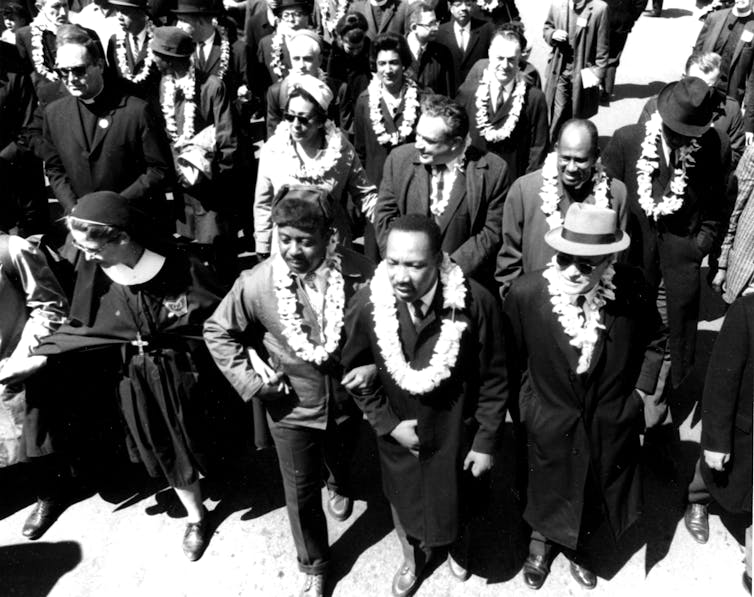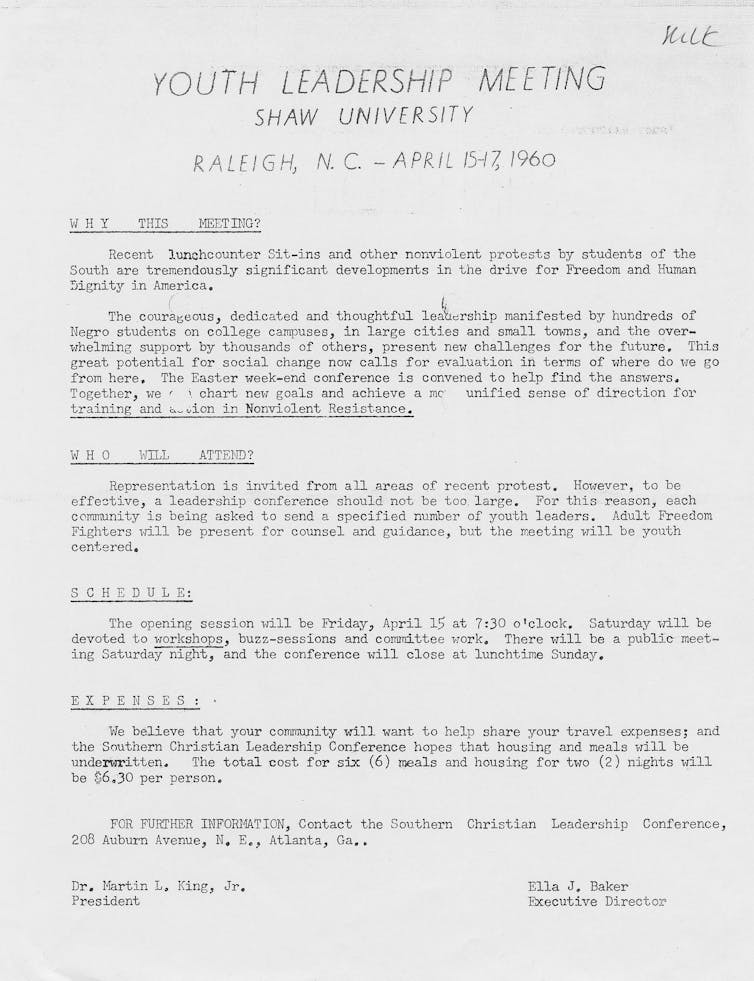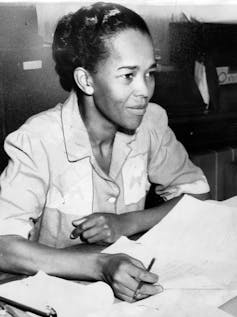There are many leaders of today's protest movement – just like the civil rights movement
- Written by Sarah Silkey, Professor of History and Social and Economic Justice, Lycoming College
The recent wave of protests against police brutality and systemic racism has inspired numerous comparisons with the civil rights movement of the 1950s and 1960s.
Commentators frequently depict the charismatic leadership[1] of Martin Luther King Jr. and Malcolm X in sharp contrast with the decentralized[2] and seemingly leaderless nature of the current movement.
Despite the efforts of activists[3] and historians[4] to correct this “leaderless” image, the notion persists[5]. Such comparisons reflect the cultural memory – not the actual history – of the struggle for Black equality.
Heroic struggle led by charismatic men
Through collective remembering and forgetting, societies build narratives of the past to create a shared identity – what scholars refer to as cultural memory[6].
The civil rights movement is remembered as a heroic struggle against injustice led by charismatic men. That is not the whole story.
King’s soaring rhetoric[7] and Malcolm’s unflinching social critiques[8] have supplanted recollection of the significant work performed by legions of local leaders, whose grassroots organizational style more closely resembled the efforts of Black Lives Matter activists and other contemporary social justice groups to build movements full of leaders[9].
The iconic images[10] of 1950s and 1960s Black protesters marching, kneeling and being arrested while dressed in their “Sunday best” illustrated the respectability politics[11] of the day.
 American Civil Rights leader Dr. Martin Luther King Jr., flanked by Rev. Ralph Abernathy (center left) and Nobel Prize-winning political scientist and diplomat Ralph Bunche (center right) during the third Selma to Montgomery, Alabama march for voting rights, March 21, 1965.
PhotoQuest/Getty Images[12]
American Civil Rights leader Dr. Martin Luther King Jr., flanked by Rev. Ralph Abernathy (center left) and Nobel Prize-winning political scientist and diplomat Ralph Bunche (center right) during the third Selma to Montgomery, Alabama march for voting rights, March 21, 1965.
PhotoQuest/Getty Images[12]
[Get facts about coronavirus and the latest research. Sign up for The Conversation’s newsletter.[13]]
These efforts, designed to cultivate white sympathy for civil rights activists, relied on conformity with patriarchal gender roles[14] that elevated men[15] to positions of visible leadership, confined women[16] to the background and banished LGBTQ individuals[17] to the closet.
Yet the movement could not have happened without the extraordinary leadership of Black women like veteran organizer Ella Baker[18]. Baker’s model of grassroots activism and empowerment for young and marginalized people became the driving force of the Student Nonviolent Coordinating Committee[19], known as SNCC, and other nonviolent protest organizations, past and present.
 Flyer announcing a Youth Leadership Meeting, that was to be held at Shaw University, Raleigh, North Carolina, on April 15-17, 1960, and bearing the names of Dr. Martin Luther King Jr. and Ella J. Baker, the president and executive director, respectively, of the Southern Christian Leadership Conference, April 1960.
New York Public Library/From the New York Public Library/Smith Collection/Gado/Getty Images).[20]
Flyer announcing a Youth Leadership Meeting, that was to be held at Shaw University, Raleigh, North Carolina, on April 15-17, 1960, and bearing the names of Dr. Martin Luther King Jr. and Ella J. Baker, the president and executive director, respectively, of the Southern Christian Leadership Conference, April 1960.
New York Public Library/From the New York Public Library/Smith Collection/Gado/Getty Images).[20]
The decentralized structure of the current movement builds on this history of grassroots activism while working to avoid replicating[21] the entrenched sexism[22] and homophobia[23] of an earlier era.
Amplifying voices
SNCC transformed lives by recognizing talent and empowering marginalized people. As Joe Martin, one of the organizers of a student walkout in McComb, Mississippi, recalled[24], “If you had a good idea it was accepted regardless of what your social status was.”
 Ella Baker, NAACP Hatfield representative, Sept. 18, 1941.
Afro American Newspapers/Gado/Getty Images[25]
Ella Baker, NAACP Hatfield representative, Sept. 18, 1941.
Afro American Newspapers/Gado/Getty Images[25]
Endesha Ida Mae Holland, a teenage prostitute, found purpose as a SNCC field secretary, organizing and leading marches in Greenwood, Mississippi. Facing down Police Chief Curtis Lary “made me feel so proud,” she recalled[26], and “people start looking up into my face, into my eyes” with respect. Holland went on to become an award-winning playwright[27] and distinguished university professor[28].
Black Lives Matter co-founders Alicia Garza and Patrisse Cullors also encourage strategies that place marginalized voices at the center.
Elevating “Black trans people, Black queer people, Black immigrants, Black incarcerated people and formerly incarcerated people, Black millennials, Black women, low income Black people, and Black people with disabilities” to leadership roles, they wrote[29], “allows for leadership to emerge from our intersecting identities, rather than to be organized around one notion of Blackness.”
Black women[30] and teens[31] have played a critical role in organizing, leading and maintaining the momentum of recent protests.
Kimberly Jones captured the nation’s attention[32] with an impassioned takedown[33] of institutional racism and debates over appropriate forms of protest. After repeatedly breaking the social contract to keep wealth and opportunity out of reach for black communities, Jones concludes, white Americans “are lucky that what black people are looking for is equality and not revenge.”
Women have organized family-friendly demonstrations, including the “Black Mamas March[34]” in Charlotte, North Carolina, and a “Black Kids Matter[35]” protest in Hartford, Connecticut.
Six young women, aged 14 to 16, organized a peaceful protest attracting more than 10,000 people in Nashville, Tennessee[36], while 17-year-old Tiana Day led a march on the Golden Gate Bridge[37] in San Francisco.
 Seventeen-year-old Tiana Day leads a march on the Golden Gate Bridge in San Francisco, June 6, 2020, to protest the death of George Floyd.
AP Photo/Jeff Chiu[38]
Seventeen-year-old Tiana Day leads a march on the Golden Gate Bridge in San Francisco, June 6, 2020, to protest the death of George Floyd.
AP Photo/Jeff Chiu[38]
Full of leaders
The adaptive “low ego/high impact[39]” leadership model, in which leaders serve as coaches helping groups build their own solutions, has become popular among current social justice organizations, but it is not new.
Baker encouraged[40] civil rights organizations to “develop individuals” and provide “an opportunity for them to grow.” She praised SNCC for “working with indigenous people, not working for them.”
“You don’t have to worry about where your leaders are,” former SNCC organizer[41] Robert Moses reflected[42]. “If you go out and work with your people, then the leadership will emerge.”
Campaigns are exhausting[43] and external recognition as a “leader” can take a heavy toll. Spreading leadership around helps to protect any one person from becoming a target[44] for retaliation while advancing a stream of talent to rise as individual energy wanes.
Returning from a citizenship training program in Charleston, South Carolina, in 1963, Fannie Lou Hamer[45] was arrested and severely beaten[46], leaving her with permanent injuries. Holland’s mother died when their house in Greenwood, Mississippi, was bombed[47] in 1965 in retaliation for her activism.
Civil rights worker Anne Moody[48] recounted[49] how the physical and psychological toll of constant harassment by white supremacists in 1963 forced her to leave a voter registration drive in Canton, Mississippi, saying “I was on the verge of a breakdown” and “would have died from lack of sleep and nervousness” had she stayed “another week.”
In a 2017 interview[50], Erica Garner, who became a tireless campaigner against police brutality after her father, Eric Garner, died from a New York police officer’s chokehold in 2014, echoed Moody’s comments.
“I’m struggling right now with the stress and everything. … The system beats you down to where you can’t win,” she said. Just three weeks after that interview, Erica Garner died[51] of a heart attack at the age of 27.
Comparisons to the romanticized cultural memory of charismatic leadership in the Civil Rights Movement devalues the hard work of today’s activists – as well as those who worked hard outside of the limelight in the earlier movement. Social change – then and now – derives from a critical mass of local work throughout the nation. Those who cannot find leaders in this movement are not looking hard enough.
References
- ^ charismatic leadership (theconversation.com)
- ^ decentralized (www.aclu.org)
- ^ activists (stproject.org)
- ^ historians (www.colorlines.com)
- ^ persists (youtu.be)
- ^ cultural memory (www.iea.usp.br)
- ^ rhetoric (www.archives.gov)
- ^ critiques (americanradioworks.publicradio.org)
- ^ full of leaders (www.huffpost.com)
- ^ iconic images (www.aarp.org)
- ^ respectability politics (www.dissentmagazine.org)
- ^ PhotoQuest/Getty Images (www.gettyimages.com)
- ^ Sign up for The Conversation’s newsletter. (theconversation.com)
- ^ patriarchal gender roles (chicagounbound.uchicago.edu)
- ^ men (www.jstor.org)
- ^ women (www.loc.gov)
- ^ LGBTQ individuals (digitalcommons.unl.edu)
- ^ Ella Baker (snccdigital.org)
- ^ Student Nonviolent Coordinating Committee (snccdigital.org)
- ^ New York Public Library/From the New York Public Library/Smith Collection/Gado/Getty Images). (www.gettyimages.com)
- ^ avoid replicating (blacklivesmatter.com)
- ^ sexism (www.britannica.com)
- ^ homophobia (www.britannica.com)
- ^ recalled (www.press.uillinois.edu)
- ^ Afro American Newspapers/Gado/Getty Images (www.gettyimages.com)
- ^ recalled (clarityfilms.org)
- ^ playwright (www.latimes.com)
- ^ university professor (news.usc.edu)
- ^ wrote (www.huffpost.com)
- ^ Black women (www.thelily.com)
- ^ teens (www.washingtonpost.com)
- ^ captured the nation’s attention (www.publishersweekly.com)
- ^ takedown (youtu.be)
- ^ Black Mamas March (www.charlotteobserver.com)
- ^ Black Kids Matter (www.courant.com)
- ^ Nashville, Tennessee (www.tennessean.com)
- ^ Golden Gate Bridge (www.courthousenews.com)
- ^ AP Photo/Jeff Chiu (www.apimages.com)
- ^ low ego/high impact (changeelemental.org)
- ^ encouraged (uncpress.org)
- ^ former SNCC organizer (www.ibiblio.org)
- ^ reflected (www.hup.harvard.edu)
- ^ exhausting (www.theroot.com)
- ^ target (youtu.be)
- ^ Fannie Lou Hamer (www.womenshistory.org)
- ^ arrested and severely beaten (www.pbs.org)
- ^ bombed (snccdigital.org)
- ^ Anne Moody (www.blackpast.org)
- ^ recounted (www.penguinrandomhouse.com)
- ^ interview (twitter.com)
- ^ died (www.nytimes.com)
Authors: Sarah Silkey, Professor of History and Social and Economic Justice, Lycoming College


